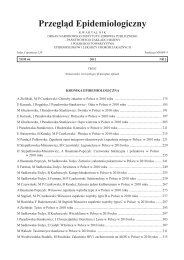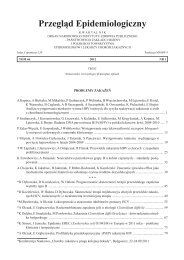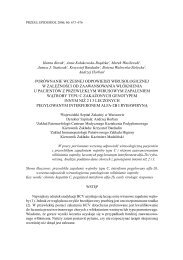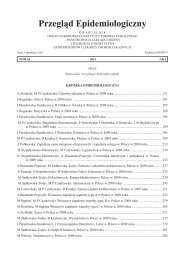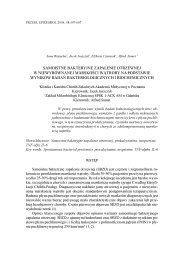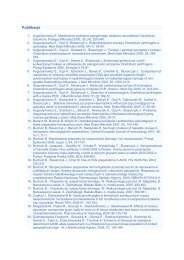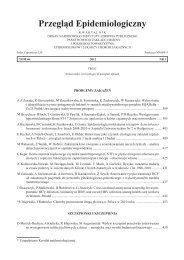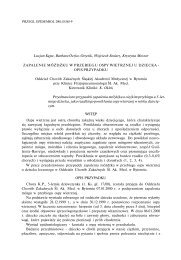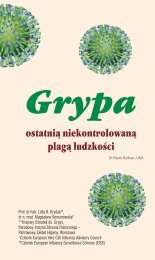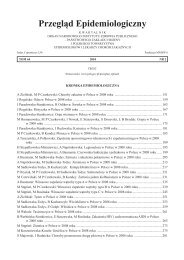Przegląd Epidemiologiczny - Państwowy Zakład Higieny
Przegląd Epidemiologiczny - Państwowy Zakład Higieny
Przegląd Epidemiologiczny - Państwowy Zakład Higieny
Create successful ePaper yourself
Turn your PDF publications into a flip-book with our unique Google optimized e-Paper software.
Nr 4<br />
pacjentem, zwłaszcza w pierwszym roku leczenia. Jest<br />
to najtrudniejszy okres dla pacjenta, który musi nauczyć<br />
się systematyczności, przejść przez pierwszy okres<br />
nasilonych objawów niepożądanych, zaakceptować, że<br />
leki będzie przyjmować nieprzerwanie przez wiele lat,<br />
najprawdopodobniej do końca życia. Obecnie jednym<br />
z głównych wyzwań opieki nad pacjentami zakażonymi<br />
HIV jest ich utrzymanie przez jak najdłuższy czas<br />
na skutecznym leczeniu ARW. Aby było to możliwe,<br />
potrzebna jest ścisła współpraca interdyscyplinarnego<br />
zespołu medycznego składającego się z lekarza chorób<br />
zakaźnych, psychiatry, psychologa, pracownika socjalnego<br />
i pielęgniarki, którzy będą wyprzedzać potencjalne<br />
zagrożenia mogące powodować przerwanie terapii, a nie<br />
działać dopiero w sytuacji wystąpienia takiej sytuacji.<br />
PODSUMOWANIE<br />
1. Przerwanie leczenia antyretrowirusowego to znaczący<br />
problem, który występował aż u 38,8% pacjentów.<br />
2. Leczenie przerywane było częściej w pierwszym<br />
roku terapii i dotyczyło szczególnie często osób zakażonych<br />
poprzez stosowanie dożylnych środków<br />
odurzających, dlatego ta grupa pacjentów wymaga<br />
specjalnego przygotowania do terapii.<br />
PIŚMIENNICTWO<br />
1. Crum NF, Riffenburgh RH, Wegner S, i in. Triservice<br />
AIDS Clinical Consortium. Comparisons of causes of<br />
death and mortality rates among HIV infected persons:<br />
analysis of the pre-, early, and late HAART (highly active<br />
antiretroviral therapy) eras. J Acquir Immune Defic Syndr<br />
2006;41(2):194-200.<br />
2. Mocroft A, Ledergerber B, Katlama C, i in. EuroSIDA<br />
study group. Decline in the AIDS and death rates in the<br />
EuroSIDA study: an observational study. Lancet 2003<br />
Jul 5;362(9377):22-9.<br />
3. Conway B. The role of adherence to antiretroviral<br />
therapy in the management of HIV infection. JAIDS<br />
2007;45:S14–S18.<br />
4. Maggiolo F, Airoldi M, Kleinloog HD, i in. Effect of<br />
adherence to HAART on virologic outcome and on the selection<br />
of resistance-conferring mutations in NNRTI- or<br />
PI-treated patients. HIV Clin Trials 2007;8(5):282-292.<br />
5. Schackman BR, Gebo KA, Walensky RP, i in.The lifetime<br />
cost of current human immunodeficiency virus care in<br />
the United States. Med Care 2006;44: 990-997.<br />
6. Hogg RS, Heath K, Bangsberg D, i in. Intermittent use<br />
of triple combination therapy is predictive of mortality<br />
at baseline and after one year of follow-up. AIDS<br />
2002;16:1051–1058.<br />
7. Riley ED, Bangsberg DR, Guzman D, i in. Antiretroviral<br />
therapy, hepatitis C virus and AIDS mortality among San<br />
Przyczyny przerwania leczenia antyretrowirusowego 495<br />
Francisco’s homeless and marginally housed. JAIDS<br />
2005;38:191–195.<br />
8. Chen RY, Westfall AO, Mugavero MJ, i in. Duration of<br />
highly active antiretroviral therapy regimens. Clin Inf<br />
Dis 2003;37:714–722.<br />
9. D’Arminio MA, Cozzi-Lepri A, Phillips A, i in. Interruption<br />
of highly active antiretroviral therapy in HIV clinical<br />
practice: Results from the Italian cohort of antiretroviral<br />
naive patients. JAIDS 2005;38:407–416.<br />
10. Mocroft A, Phillips AN, Soriano V, i in. Reasons for<br />
stopping antiretrovirals used in an initial highly active<br />
antiretroviral regimen: Increased incidence of stopping<br />
due to toxicity or patient/physician choice in patients<br />
with hepatitis C co-infection. AIDS Research and Human<br />
Retroviruses 2005;21:527–536.<br />
11. Dray-Spira R, Spire B, Heard I, i in. VESPA Study Group<br />
Heterogeneous response to HAART cross a diverse<br />
population of HIV-infected individuals. Results from the<br />
ANRS-EN12-VESPA study. AIDS 21(Suppl1):S5–S12.<br />
12. Yuan Y, L’italien G, Mukherjee J, i in. Determinants of<br />
discontinuation of initial highly active anti-retroviral<br />
therapy regimens in a US HIV-infected patient cohort.<br />
HIV Medicine 2006;7:156–162.<br />
13. Mocroft A, Youle M, Moore A, i in. Reasons for modification<br />
and discontinuation of antiretrovirals: results from<br />
a single treatment centre. AIDS 2001;15:185-194.<br />
14. Li X, Margolick JB, Conover CS, i in. Interruption and discontinuation<br />
of highly active antiretroviral therapy in the<br />
multicenter AIDS cohort study. JAIDS 2005;38:320–328.<br />
15. Moatti JP, Carrieri MP, Spire B, i in. Adherence to HA-<br />
ART in French HIV-infected injecting drug users: the<br />
contribution of buprenorphine drug maintenance treatment.<br />
The Manif 2000 study group. AIDS 2000;14:151–<br />
155.<br />
16. Samet JH, Horton NJ, Meli S, i in. Alcohol consumption<br />
and antiretroviral adherence among HIV-infected persons<br />
with alcohol problems. Alcoholism. Clin Exp Med<br />
2004;28:572–577.<br />
Otrzymano: 20.05.2010 r.<br />
Zaakceptowano do druku: 12.07.2010 r.<br />
Adres do korespondencji:<br />
Dr Elżbieta Jabłonowska<br />
Klinika Chorób Zakaźnych i Hepatologii<br />
Uniwersytetu Medycznego w Łodzi<br />
91-347 Łódź<br />
ul. Kniaziewicza 1/5



